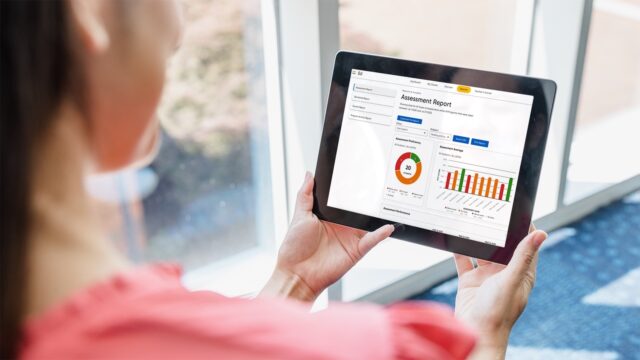
Many of us in education have heard of “data-driven decision-making,” but depending on whom you ask, the meaning of these words can vary. So, what is data-driven decision-making really, and why is it so important? As a public educator for many years, I’ve experienced the process of collecting multiple sources of data, both qualitative and quantitative. Some examples include:
- Formative assessments
- Summative assessments
- Interim assessments
This data provided educators and me with a plethora of information, but what we would do with that data would vary depending on our background knowledge in making data-informed decisions. At the time, that wasn’t much, as data-driven instruction in education had been an emerging field and continues to evolve to this day.
What is data-driven decision-making in education?
Data-driven decision-making (or data-based decision-making) in education can be defined as a process that requires us to not only collect evidence of learning but also analyze and interpret that evidence to make informed decisions about teaching and learning. Educators must also use learner context to effectively transform their data into actionable knowledge, ultimately improving student performance. This can change how we think about data in the classroom, campus, or district.
Why is data-driven decision-making important in education?
Educators in any capacity are always striving for continuous improvement for both their students and themselves. This endeavor looks differently for everyone and can include gaining a better understanding of content, providing better quality instruction, utilizing timely and effective feedback, creating and administering purposeful assessment, supporting campus improvement, or setting goals for students and teachers. When attempting these endeavors, it’s important to use quality, reliable data to determine the best opportunities for growth.
Imagine you are in a data meeting with your team, and you are analyzing and interpreting the results of the most recent assessment. Effective communication is essential to ensure that everybody on the team understands why the data have been collected and how decisions will be made, especially when using data protocols (or step-by-step guidelines for analyzing and using data) that require collaboration and cohesive decision-making. It’s important that each individual team member becomes data literate to efficiently and effectively utilize both individual and team-wide data.
The importance of data literacy
Data literacy in education is educators’ ability to effectively use data to inform their practice. It’s taking the many forms of data that we have and transforming them into actionable ways to facilitate change. In order to do this successfully, it’s important to remember that the quality of the assessment not only determines the quality of the evidence gathered but, in turn, affects the impact of data-informed decisions.
Assessment literacy and data literacy go hand in hand. Data often come from assessments, and educators are ideally able to both provide the right assessments for the right purposes and make sense of the resulting data. Those who are assessment literate understand how to gather dependable evidence and use it productively to support or certify achievement. Those who are data literate know how to transform data into actionable knowledge. Educators need good data to make good decisions.
When looking through the lens of school campuses, school leaders sometimes assume that all teachers and administrators can use data to understand the scope and reasons behind their students’ academic achievements, as well as determine targeted, responsive improvement plans based on this data. Effectively using data is a huge responsibility, and multiple data sources can inform classroom, campus, and even district-wide decisions. One example is state performance data, which are commonly used to drive campus improvement. However, campuses won’t make gains simply by knowing their students’ scores on the state assessment. Schools must develop frequent and specific data-driven systems for monitoring student learning to see large-scale achievement and/or growth gains.
Effectively using data is a huge responsibility, and multiple data sources can inform classroom, campus, and even district-wide decisions.
NWEA Consultant, State Professional Learning & Improvement Services, HMH
Examples of data-driven decision-making in education
As I learned more about data-driven decision-making as an educator, I found myself practicing it more and more as a classroom teacher, instructional coach, district coordinator, and in other capacities. Now that you have a more developed understanding of what it is, let’s talk about what it looks like in action, as it can take many forms. Here are just a few examples of data-driven decision-making in education, based on my experiences.
What does data-driven decision-making look like in a classroom?
- Formative assessments in the form of classroom observations: As a classroom teacher, I directly instructed many concepts in middle school mathematics. After I taught a lesson, students usually had a performance task within their groups to work on collaboratively and apply both new knowledge and any pre-requisite knowledge that they might need. My role as the teacher was to move around the room and listen to students’ academic conversations. I gathered informal data on misconceptions and academic vocabulary utilization. Then I provided support in forms like questioning and recommending specific mathematical tools. This data would sometimes inform an immediate decision to stop the class and review a common misconception with the whole group. Once class was over, I would review alternative instructional strategies to teach the same concept in a different way, and I would plan to include more academic vocabulary to help solidify students’ understanding.
- Summative assessment in the form of student work samples: As an instructional coach, I supported many grade-level data meetings to review district assessment data. We would use some type of data protocol and review content standards for mastery. We entered the data into a spreadsheet, and then we worked to create possible groupings for students based on specific needs and plan whole-group re-teaches for standards that were missed by over half of the students. We analyzed qualitative data as well by examining student work samples to determine what instructional strategies were not being used successfully. We discussed the possible points of confusion for students. This plan helped to dictate both small-groups and whole-class instruction, as well as calibrate the most highly effective strategies across the entire grade-level team.
What does data-driven decision-making look like for campus and/or district leaders?
- Formative assessment in the form of classroom observations: As a district math coordinator, I was able to support campuses by ensuring teachers had access to a strong mathematics curriculum and by doing campus walk-throughs to identify specific needs. I collected informal data, such as the effectiveness of a specific lesson or assessment or whether there’s evidence of student engagement, student discourse, or teacher content knowledge. This data determined the type of support that I delivered when meeting with teams and what improvements teachers need in the curriculum. One year, for instance, we created a specific goal of creating more opportunities for student discourse and implemented number talks as a daily numeracy routine for all grade levels. This refers to an effective strategy for building numeracy that is student-led and allows for more student discourse during learning.
- Summative data in the form of state assessment results: State assessment results can serve a wide range of needs. Administrators at both the campus and district level can analyze grade-level performance and measure the progress of student cohorts. The data can be used to identify where academic support is most needed and what resources can best provide that support. For example, the data can be used to create assessments or professional development targeted to students’ and teachers’ specific areas of need.
Data-driven decision-making in education: pros and cons
As we continue to look at data to make informed decisions, it’s important to remember the purpose of each measurement. Some data sets have established valid measures to support data-driven change, but sometimes, educational policy incorrectly assumes that data from one measurement system for one purpose can be used for other purposes. There are limitations to data-driven decision-making, and accountability goals shouldn’t inform, say, campus improvement. Oftentimes, this is where frustration surfaces, as educators and policymakers try to use the wrong tool for the task at hand. It’s like hiring an excavator to pull a few weeds when a garden shovel will suffice!
Another limitation in data-driven decision-making is the potential of using inaccurate data to inform instructional decisions. This highlights the benefits of using multiple data sources to inform our decisions. State assessments have their place but are rarely informative enough to create actionable knowledge solely based on their information. It’s the frequent and specific data-driven systems that are developed on campuses and in classrooms that will provide the most significant instructional insights.
Ultimately, using data to drive instruction within the classroom is the most effective way to increase student achievement and growth. As an educator, I want to encourage you to continue strengthening your relationship with data, as it can be a beautiful thing for all students and staff when used effectively.
***
For more on the importance of data-driven decision-making in education—specifically, in the classroom—read our blogs “What Is Data-Driven Instruction in Education?” and “How to Use Data to Drive Instruction in the Classroom.”
***
Explore how leaders can effectively measure progress and adjust strategies throughout the school year with our recorded webinar, “Beyond the Plan: Measuring, Adjusting and Realigning Strategies for Success.”
Discover how HMH assessments can help educators make data-driven decisions in education.
Sources used
Bryk, A., Gomez, L., Grunow, A., & LeMahieu, P. (2021). Learning to Improve: Different types of measures are used for different purposes. Harvard Education Press.
Mandinach, E., & Jackson, S. (2012). Transforming Teaching and Learning through Data-Driven Decision-Making (1st ed.). Corwin & SAGE Publications.
Build a data-driven culture in your school or district.














